Popular categories
Looking for a yarn?
Order DROPS Needles & Hooks
Clicking the ORDER button will redirect you to Wool Warehouse Direct Ltd website
The yarn cost is calculated from the pattern’s smallest size and the yarn’s cheapest product type. Looking for an even better price? You might find it on the DROPS Deals!
Perfect Day
Knitted shoulder piece in 4 strands DROPS Air. The piece is worked top down with stocking stitch and moss stitch. Sizes S - XXXL.
DROPS Design: Pattern no ai-133
Yarn group C + C + C + C or F
-------------------------------------------------------
Sizes: S - M - L - XL – XXL - XXXL
Materials:
DROPS AIR from Garnstudio (belongs to yarn group C)
400-400-450-500-550-600 g colour 12, moss green
-------------------------------------------------------
ACCESSORIES FOR THE PIECE:
KNITTING TENSION:
5.5 stitches in width and 7 rows in height with stocking stitch and 4 strands = 10 x 10 cm.
NEEDLES:
DROPS CIRCULAR NEEDLE SIZE 20 MM: length 80 cm.
The needle size is only a guide. If you have too many stitches on 10 cm, change to a larger needle size. If you have too few stitches on 10 cm, change to a smaller needle size.
-------------------------------------------------------
-------------------------------------------------------
Alternative Yarn – See how to change yarns here
Yarn Groups A to F – Use the same pattern and change the yarn here
Yarn usage using an alternative yarn – Use our yarn converter here
-------------------------------------------------------
Order DROPS Needles & Hooks
Clicking the ORDER button will redirect you to Wool Warehouse Direct Ltd website
The yarn cost is calculated from the pattern’s smallest size and the yarn’s cheapest product type. Looking for an even better price? You might find it on the DROPS Deals!
- English (UK/cm)
- Česky
- Dansk
- Deutsch
- Eesti keel
- English (US/in)
- Español
- Français
- Íslenska
- Italiano
- Magyar
- Nederlands
- Norsk
- Polski
- Português
- Suomi
- Svenska
- English (UK/cm), Bulgaria
- English (UK/cm), Croatia
- English (UK/cm), Greece
- English (UK/cm), Latvia
- English (UK/cm), Lithuania
- English (UK/cm), Romania
- English (UK/cm), Slovenia
- Česky, Slovakia
Pattern instructions
-------------------------------------------------------
MOSS STITCH:
ROW 1: * Knit 1, purl 1 *, work from *-*.
ROW 2: Purl over knit and knit over purl.
Repeat row 2.
INCREASE TIP-1:
All increases made from the right side!
Increase 1 stitch by making 1 yarn over. On the next row purl the yarn over twisted to avoid a hole. Then work new stitch in stocking stitch.
INCREASE TIP-2 (evenly spaced):
To work out how to increase evenly, count the total number of stitches on the needle (e.g. 82 stitches) minus the 2 stitches in moss stitch in each side (= 4 stitches) and divide the remaining stitches by the number of increases to be made (e.g. 10) = 7.8. In this example, increase by making 1 yarn over alternately after each 7th and 8th stitch (approx.). On the next row work the yarn overs twisted to avoid holes.
-------------------------------------------------------
START THE PIECE HERE:
-------------------------------------------------------
SHOULDER PIECE - SHORT OVERVIEW OF THE PIECE:
The piece is worked back and forth with circular needle, top down and sewn together in sides under the sleeves.
SHOULDER PIECE:
Cast on 35-37-37-39-39-41 stitches with circular needle size 20 mm and 4 strands Air. Work MOSS STITCH - read description above, for 10 cm – adjust so that the next row is worked from the right side. Now work pattern as follows: 2 stitches in moss stitch, stocking stitch until there are 2 stitches left, 2 stitches in moss stitch. REMEMBER THE KNITTING TENSION! When the piece measures 20 cm cast on 4 new stitches at the end of the next 2 rows for sleeves = 43-45-45-47-47-49 stitches. Continue with pattern as follows: 6 stitches in moss stitch, stocking stitch until there are 6 stitches left, 6 stitches in moss stitch. When the piece measures 37-38-39-40-41-42 cm increase 1 stitch inside the 6 stitches in moss stitch in each side - read INCREASE TIP-1. Increase like this every 6 cm a total of 3 times (= 6 stitches increased) = 49-51-51-53-53-55 stitches. When the piece measures 34-36-38-40-42-44 cm from where you cast on stitches for sleeves, cast off 4 stitches at the beginning of the next 2 rows for sleeves = 41-43-43-45-45-47 stitches. Continue with stocking stitch and 2 stitches in moss stitch in each side until the piece measures 10 cm from where you cast off stitches for sleeves. Knit 1 row where you increase 10-10-12-12-14-14 stitches evenly over the stitches in stocking stitch - read INCREASE TIP-2 = 51-53-55-57-59-61 stitches. Now work moss stitch over all stitches for 10 cm. Cast off with purl over knit and knit over purl. If the cast-off edge is tight you can make 1 yarn over after each 4th stitch (yarn overs cast off as normal stitches).
ASSEMBLY:
Sew sleeve and side seams in one go – see broken line in sketch. Sew in outermost loop of outermost stitch so the seam is flat.
Diagram

|
= knitting direction |

|
= the sketch shows how the garment looks after assembly |
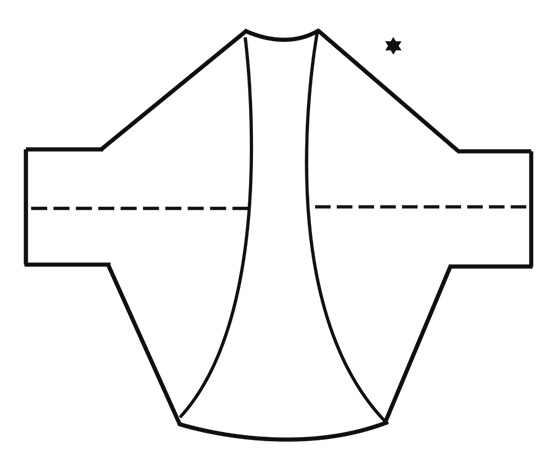
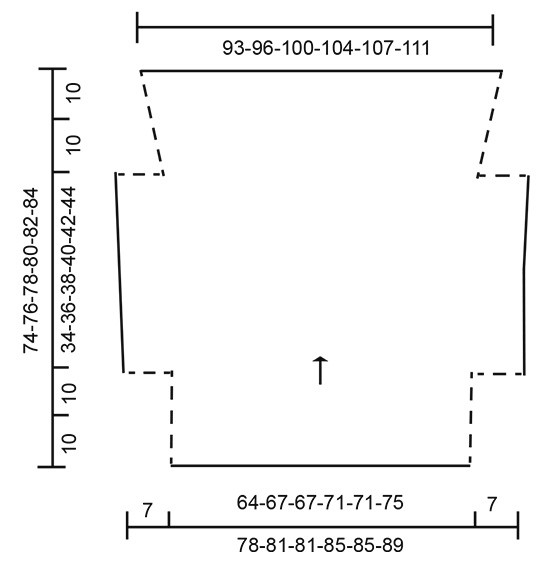
What can you do with our patterns? You can share DROPS patterns online, using the pattern original picture, materials, name and number. But you are NOT ALLOWED to reproduce the complete pattern digitally in any way. Yarn stores are welcome to use the DROPS pattern database to promote the sale of our assortment. You can print out our patterns, make as many copies as you’d like. The only thing we ask is that you don't make any changes / additions to the original printed document. And that the patterns according to the DROPS philosophy are given out to the consumers for free. Editorials that wish to publish our patterns in printed books or magazines can contact us for more information. The sale of garments based on DROPS patterns is permitted as long as they are sold as single items or per order. Further commercial use of the patterns is not permitted. It has to be clearly stated that the garment is made based on a design from DROPS DESIGN. The use of clothing labels of which DROPS DESIGN forms part is conditioned by the inclusion of the following text: “A DROPS DESIGN made by …..”. The use of DROPS photos for marketing purposes/sales is only permitted in connection with the use/sale of DROPS products. The photos may not be cut or edited and the logo should be clearly visible.
We reserve the right to withdraw the permission for use of our patterns at any time, notwithstanding the reason.
Each of our patterns has specific tutorial videos to help you.
These step-by-step tutorials might also help you:
Why is the knitting/crochet tension so important?
Knitting tension is what determines the final measurements of your work, and is usually measured per 10 x 10 cm. It is provided like so: number of stitches in width x number of rows in height - eg: 19 stitches x 26 rows = 10 x 10 cm.
The knitting tension is very individual; some people knit/crochet loosely while others work tightly. You adjust the knitting tension with the needle size, which is why the suggested needle size is only meant as a guide! You need to adjust this (up or down) to ensure that YOUR knitting tension matches the knitting tension provided in the pattern. If you work with a different knitting tension than provided you will have a different yarn consumption, and your work will have different measurements than what the pattern suggests.
The knitting tension also determines which yarns can replace each other. As long as you achieve the same knitting tension you can replace one yarn with another.
See DROPS lesson: How to measure your tension/gauge
See DROPS video: How to make a gauge tension swatch
How do I know how many balls of yarn I need?
The required amount of yarn is provided in grams, eg: 450 g. To calculate how many balls you’ll need you first need to know how many grams are in 1 ball (25g, 50g or 100g). This information is available if you click on the individual yarn quality on our pages. Divide the amount required with the amount of each ball. For example, if each ball is 50g (the most common amount), the calculation will be as follows: 450 / 50 = 9 balls.
Can I use a different yarn than what the pattern suggests?
The important thing when changing from one yarn to another is that the knitting/crochet tension remains the same. This is so that the measurements of the finished piece will be the same as on the sketch provided. It is easier to achieve the same knitting tension using yarns from the same yarn group. It is also possible to work with multiple strands of a thinner yarn to achieve the knitting tension of a thicker one. Please try our yarn converter. We recommend you to always work a test swatch.
Please NOTE: when changing yarn the garment might have a different look and feel to the garment in the photo, due to individual properties and qualities of each yarn.
See DROPS lesson: Can I use a different yarn than the one mentioned in the pattern?
What are the yarn groups?
All our yarns are categorised into yarn groups (from A to F) according to thickness and knitting tension – group A contains the thinnest yarns and group F the thickest. This makes it easier for you to find alternative yarns to our patterns, should you wish to switch yarn. All yarns within the same group have a similar knitting tension and can easily replace each other. However, different yarn qualities have different structures and properties which will give the finished work a unique look and feel.
How do I use the yarn calculator?
At the top of all our patterns you’ll find a link to our yarn calculator, which is a helpful tool should you wish to use a different yarn than suggested. By filling in the yarn quality you wish to replace, the amount (in your size) and number of strands, the calculator will present good alternative yarns with the same knitting tension. Additionally it will tell you how much you’ll require in the new qualities and whether you’ll need to work with multiple strands. Most skeins are 50g (some are 25g or 100g).
If the pattern is worked with multiple colours, every colour will have to be calculated separately. Similarly, if the pattern is worked with several strands of different yarns (for example 1 strand Alpaca and 1 strand Kid-Silk) you will have to find alternatives for each, individually.
Why do you show discontinued yarns in the patterns?
Since different yarns have different qualities and textures we have chosen to keep the original yarn in our patterns. However, you can easily find options among our available qualities by using our yarn calculator, or simply pick a yarn from the same yarn group.
It is possible that some retailers still have discontinued yarns in stock, or that someone has a few skeins at home that they would like to find patterns for.
The yarn calculator will provide both alternative yarn as well as required amount in the new quality.
What size should I knit?
If you think it's hard to decide what size to make, it can be a good idea to measure a garment you own already and like the size of. Then you can pick the size by comparing those measures with the ones available in the pattern's size chart.
You'll find the size chart at the bottom of the pattern.
See DROPS lesson: How to read size chart
Why do I get the wrong knitting tension with the suggested needle size?
The needle size provided in the pattern serves only as a guide, the important thing is to follow the knitting tension. And since knitting tension is very individual, you will have to adjust the needle size to ensure that YOUR tension is the same as in the pattern – maybe you’ll have to adjust 1, or even 2 needle sizes, up or down to achieve the correct tension. For this, we recommend that you work test swatches.
Should you work with a different knitting tension than the one provided, the measurements of the finished garment might deviate from the measurement sketch.
See DROPS lesson: How to measure your tension/gauge
See DROPS video: How to make a tension/gauge swatch
Why is the pattern worked top-down?
Working a garment top-down provides more flexibility and room for personal adjustment. For example it is easier to try the garment on while working, as well as making adjustments to length of yoke and shoulder caps.
The instructions are carefully explaining every step, in the correct order. Diagrams are adjusted to the knitting direction and are worked as usual.
How do I work according to a knitting diagram?
The diagram depicts all rows/rounds, and every stitch seen from the right side. It is read from bottom to top, from right to left. 1 square = 1 stitch.
When working back and forth, every other row is worked from the right side and every other row is worked from the wrong side. When working from the wrong side, the diagram will have to be worked reversed: from left to right, knit stitches are purled, purl stitches are knit etc.
When working in the round every round is worked from the right side and the diagram are worked from right to left on all rounds.
See DROPS lesson: How to read knitting diagrams
How do I work according to a crochet diagram?
The diagram depicts all rows/rounds, and every stitch seen from the right side. It is worked from bottom to top, from right to left.
When working back and forth every other row is worked from the right side: from right to left and every other row is worked from the wrong side: from left to right.
When working in the round, every row in the diagram are worked from the right side, from right to left.
When working a circular diagram you start in the middle and work your way outwards, counter clockwise, row by row.
The rows usually start with a given number of chain stitches (equivalent to the height of the following stitch), this will either be depicted in the diagram or explained in the pattern.
See DROPS lesson: How to read crochet diagrams
How do I work several diagrams simultaneously on the same row/round?
Instructions for working several diagrams after each other on the same row/round, will often be written like so: “work A.1, A.2, A.3 a total of 0-0-2-3-4 times". This means you work A.1 once, then A.2 is worked once, and A.3 is repeated (in width) the number of times provided for your size – in this case like so: S = 0 times, M = 0 times, L=2 times, XL= 3 times and XXL = 4 times.
The diagrams are worked as usual: begin with the first row in A.1, then work the first row in A.2 etc.
See DROPS lesson: How to read knitting diagrams
See DROPS lesson: How to read crochet diagrams
Why are the sleeves shorter in larger sizes?
The total width of the garment (from wrist-to-wrist) will be larger in the larger sizes, despite the actual sleeves being shorter. The larger sizes have longer sleeve caps and wider shoulders, so there will be a good fit in all sizes.
Where on the garment is the length measured?
The measurement sketch/schematic drawing provides information regarding the full length of the garment. If it’s a jumper or a jacket the length is measured from the highest point on the shoulder closest to the neckline, and straight down to the bottom of the garment. It is NOT measured from the tip of shoulder. Similarly, the length of yoke is measured from the highest point on the shoulder and down to where yoke is split into body and sleeves.
On a jacket measures are never taken along bands, unless specifically stated. Always measure inside band stitches when measuring the length.
See DROPS lesson: How to read a schematic drawing
What is a repeat?
Diagrams are often repeated on the round or in height. 1 repeat is the diagram the way it appears in the pattern. If it says to work 5 repeats of A.1 in the round, then you work A.1 a total of 5 times after/next to each other in the round. If it says to work 2 repeats of A.1 vertically/in height you work the entire diagram once, then begin again at the start and work the entire diagram one more time.
Why does the piece start with more chain stitches than it’s worked with?
Chain stitches are slightly narrower than other stitches and to avoid working the cast-on edge too tight, we simply chain more stitches to begin with. The stitch count will be adjusted on the following row to fit the pattern and measurement sketch.
Why increase before the rib edge when the piece is worked top-down?
The rib edge is more elastic and will contract slightly compared to, for example, stocking stitch. By increasing before the rib edge, you avoid a visible difference in width between the rib edge and the rest of the body.
Why increase in the cast-off edge?
It’s very easy to cast off too tightly, and by making yarn overs while casting off (and simultaneously casting these off) you avoid a too tight cast off edge.
See DROPS video: How to bind off with yarn overs (yo)
How do I increase/decrease on every 3rd and 4th row/round alternately?
To achieve an even increase (or decrease) you can increase on, for example: every 3rd and 4th row alternately, like so: work 2 rows and increase on the 3rd row, work 3 rows and increase on the 4th. Repeat this until the increase is complete.
See DROPS lesson: Increase or decrease 1 st on every 3rd and 4th row alternately
How can I work a jacket in the round instead of back and forth?
Should you prefer to work in the round instead of back and forth, you may of course adjust the pattern. You’ll need to add steeks mid-front (usually 5 stitches), and follow the instructions. When you would normally turn and work from the wrong side, simply work across the steek and continue in the round. At the end you’ll cut the piece open, pick up stitches to work bands, and cover the cut edges.
See DROPS video: How to knit steeks and cut open
Can I work a jumper back and forth instead of in the round?
Should you prefer to work back and forth instead of in the round, you may of course adjust the pattern so you work the pieces separately and then assemble them at the end. Divide the stitches for the body in 2, add 1 edge stitch in each side (for sewing) and work the front and back pieces separately.
See DROPS lesson: Can I adapt a pattern for circular needles into straight needles?
Why is the pattern slightly different than what I see in the photo?
Pattern repeats can vary slightly in the different sizes, in order to get the correct proportions. If you’re not working the exact same size as the garment in the photo, yours might deviate slightly. This has been carefully developed and adjusted so that the complete impression of the garment is the same in all sizes.
Make sure to follow instructions and diagrams for your size!
How do I make a women’s size garment into a men’s size one?
If you have found a pattern you like which is available in women’s size it’s not very difficult to convert it to men’s size. The biggest difference will be the length of sleeves and body. Start working on the women size that you think would fit across the chest. The additional length will be worked right before you cast off for the armhole/sleeve cap. If the pattern is worked top-down you can add the length right after the armhole or before the first decrease on sleeve.
Regarding additional yarn amount, this will depend on how much length you add, but it is better with a skein too many than too few.
How do I prevent a hairy garment from shedding?
All yarns will have excess fibres (from production) that might come off as lint or shedding. Brushed yarns (ie hairier yarns) have more of these loose, excess fibres, causing more shedding.
Shedding also depends on what is worn under or over the garment, and whether this pulls at the yarn fibres. It’s therefore not possible to guarantee that there will be no shedding
Below are some tips on how to get the best result when working with hairier yarns:
1. When the garment is finished (before you wash it) shake it vigorously so the looser hairs come off. NOTE: do NOT use a lint roller, brush or any method that pulls at the yarn.
2. Place the garment in a plastic bag and put it in your freezer - the temperature will cause the fibres to become less attached to each other, and excess fibres will come off easier.
3. Leave in the freezer for a few hours before taking it out and shaking it again.
4. Wash the garment according to the instructions on the yarn label.
Why does my garment pill?
Pilling is a natural process that happens to even the most exclusive of fibers. It's a natural sign of wear and tear that is hard to avoid, and that is most visible in high friction areas of your garment like a sweater's arms and cuffs.
You can make your garment look as new by removing the pilling, using a fabric comb or a pill/lint remover.
In the meantime, you can read the questions and answers that others have left to this pattern or join the DROPS Workshop on Facebook to get help from fellow knitters/crocheters!
You might also like...
Perfect Day |
|||||||
 |
 |
||||||
Knitted shoulder piece in 4 strands DROPS Air. The piece is worked top down with stocking stitch and moss stitch. Sizes S - XXXL.
DROPS 196-16 |
|||||||
|
EXPLANATIONS FOR THE PIECE: ------------------------------------------------------- MOSS STITCH: ROW 1: * Knit 1, purl 1 *, work from *-*. ROW 2: Purl over knit and knit over purl. Repeat row 2. INCREASE TIP-1: All increases made from the right side! Increase 1 stitch by making 1 yarn over. On the next row purl the yarn over twisted to avoid a hole. Then work new stitch in stocking stitch. INCREASE TIP-2 (evenly spaced): To work out how to increase evenly, count the total number of stitches on the needle (e.g. 82 stitches) minus the 2 stitches in moss stitch in each side (= 4 stitches) and divide the remaining stitches by the number of increases to be made (e.g. 10) = 7.8. In this example, increase by making 1 yarn over alternately after each 7th and 8th stitch (approx.). On the next row work the yarn overs twisted to avoid holes. ------------------------------------------------------- START THE PIECE HERE: ------------------------------------------------------- SHOULDER PIECE - SHORT OVERVIEW OF THE PIECE: The piece is worked back and forth with circular needle, top down and sewn together in sides under the sleeves. SHOULDER PIECE: Cast on 35-37-37-39-39-41 stitches with circular needle size 20 mm and 4 strands Air. Work MOSS STITCH - read description above, for 10 cm – adjust so that the next row is worked from the right side. Now work pattern as follows: 2 stitches in moss stitch, stocking stitch until there are 2 stitches left, 2 stitches in moss stitch. REMEMBER THE KNITTING TENSION! When the piece measures 20 cm cast on 4 new stitches at the end of the next 2 rows for sleeves = 43-45-45-47-47-49 stitches. Continue with pattern as follows: 6 stitches in moss stitch, stocking stitch until there are 6 stitches left, 6 stitches in moss stitch. When the piece measures 37-38-39-40-41-42 cm increase 1 stitch inside the 6 stitches in moss stitch in each side - read INCREASE TIP-1. Increase like this every 6 cm a total of 3 times (= 6 stitches increased) = 49-51-51-53-53-55 stitches. When the piece measures 34-36-38-40-42-44 cm from where you cast on stitches for sleeves, cast off 4 stitches at the beginning of the next 2 rows for sleeves = 41-43-43-45-45-47 stitches. Continue with stocking stitch and 2 stitches in moss stitch in each side until the piece measures 10 cm from where you cast off stitches for sleeves. Knit 1 row where you increase 10-10-12-12-14-14 stitches evenly over the stitches in stocking stitch - read INCREASE TIP-2 = 51-53-55-57-59-61 stitches. Now work moss stitch over all stitches for 10 cm. Cast off with purl over knit and knit over purl. If the cast-off edge is tight you can make 1 yarn over after each 4th stitch (yarn overs cast off as normal stitches). ASSEMBLY: Sew sleeve and side seams in one go – see broken line in sketch. Sew in outermost loop of outermost stitch so the seam is flat. |
|||||||
Diagram explanations |
|||||||
|
|||||||

|
|||||||

|
|||||||
|
Have you made this or any other of our designs? Tag your pictures in social media with #dropsdesign so we can see them! Do you need help with this pattern?You'll find tutorial videos, a Comments/Questions area and more by visiting the pattern on garnstudio.com. © 1982-2024 DROPS Design A/S. We reserve all rights. This document, including all its sub-sections, has copyrights. Read more about what you can do with our patterns at the bottom of each pattern on our site. |
|||||||
With over 40 years in knitting and crochet design, DROPS Design offers one of the most extensive collections of free patterns on the internet - translated to 17 languages. As of today we count 304 catalogues and 11422 patterns - 11422 of which are translated into English (UK/cm).
We work hard to bring you the best knitting and crochet have to offer, inspiration and advice as well as great quality yarns at incredible prices! Would you like to use our patterns for other than personal use? You can read what you are allowed to do in the Copyright text at the bottom of all our patterns. Happy crafting!







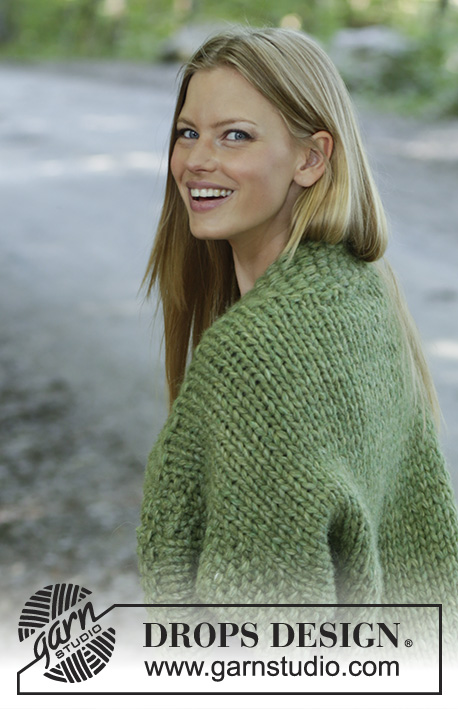

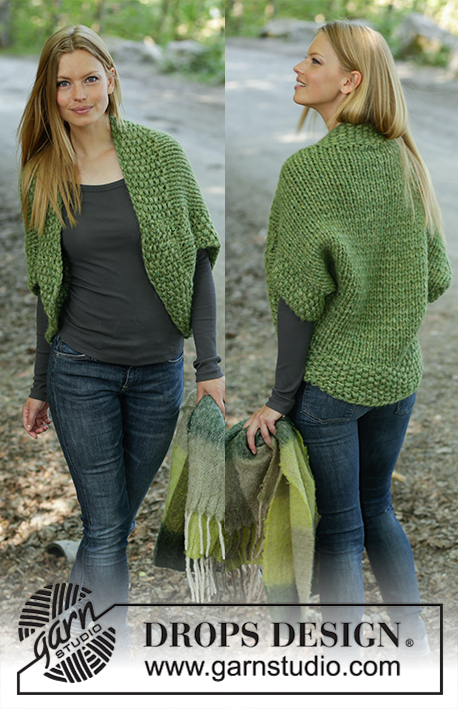


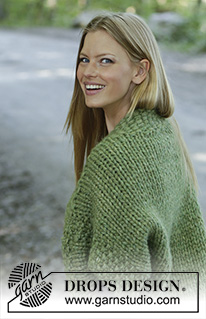
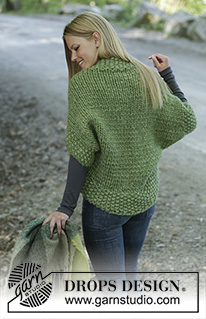
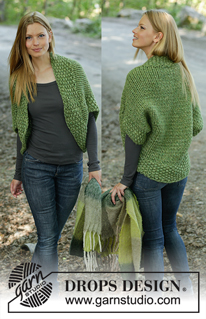












































Comments / Questions (33)
Before I purchase the yarn for this pattern I want to make sure that I have the correct information. The pattern calls for Sz 20mm or 36 (US) needles. This size needle seems extremely large for the yarn that is called for. I realize that you use 4 strands. Could you please check this and clarify. Thanks.
23.02.2022 - 20:48DROPS Design answered:
Dear Mrs Jancosko, this pattern is worked with 4 strands Air knitted together as just 1, and you should have a tension of 5,5 sts x 7 rows in stocking stitch with these 4 strands = 4"x4" with needle size 20 mm/US36. Remember to check your tension first. Happy knitting!
24.02.2022 - 10:21I would prefer not do this with 4 strands. Not confident about this. Can you suggest an alternative thicker wool weight or product that would give similar results?
14.11.2021 - 17:35DROPS Design answered:
Dear Suzanne, you could only use Polaris (group F) or 2 strands of Wish (group E) as an alternative. Happy knitting!
14.11.2021 - 18:11Hallo, ich habe eine Frage zur Skizze: unten steht (bei der kleinsten Größe 78 cm, oben 93 cm. Also unterschied von 15 cm. Die Skizze sieht aber nicht so aus also oben 15 cm Unterschied gäbe. In der Strickanleitung ergibt sich ein Unterschied von nur 8 Maschen...\r\nIst es so richtig?\r\nHerzliche Grüße \r\nJohanna
30.03.2021 - 20:56DROPS Design answered:
Liebe Johanna, Maschenprobe ist 5.5M=10 cm so sind die 35 angeschlagenen Maschen ca 64 cm; mit den 4 Maschen beidseitig sind es 43 Maschen = ca 78 cm un die 51 abgeketteten Maschen sind ca 93 cm - so stimmen alle Angaben. Viel Spaß beim stricken!
07.04.2021 - 09:10Buongiorno, è possibile eseguire lo stesso modello con ferri dritti, non circolari? grazie mille
25.11.2020 - 12:35DROPS Design answered:
Buongiorno Valentina, questo è un modello lavorato in piano, può lavorare con i ferri dritti. Buon lavoro!
25.11.2020 - 13:41Hej Er det muligt at strikke med 1 tråd Drops Polaris i stedet for 4 tråde Drops Air? vh Minna
31.10.2020 - 09:31What do you mean by '4 strands' in the first line of the pattern ...?
02.07.2020 - 20:19DROPS Design answered:
Hi Joanne, The whole garment is worked with 4 strands of Air. The best way to do this is to use either 4 balls (1 strand from each) at the same time, or 2 balls, using the strand from both the outside and inside of each ball. Happy knitting!
03.07.2020 - 07:17In the diagram above are the numbers indicated in cm? if so how can I change them to inches/
21.05.2020 - 21:11DROPS Design answered:
Hi Maryann, To change cm to inches, divide by 2.5 - so, for example, 93/2.5 = 37 inches. Happy knitting!
22.05.2020 - 07:54Non ho capito gli aghi che misura sono?
06.04.2020 - 19:11Non ho capito la misura degli aghi
06.04.2020 - 19:10DROPS Design answered:
Buongiorno Giusy. Viene consigliata la misura di ferri n. 20 o la misura che le consente di ottenere il campione indicato. Buon lavoro!
06.04.2020 - 19:41Bonjour, j’aurais une question concernant les « augmentations 1 » de ce modèle. L’explication n’est pas 100% claire pour moi. Est-ce qu’en les augmentations se font après/avant d’avoir tricoté les mailles au point de riz (=entre le point de riz et le jersey) ou en début et fin de rang? Et aussi, est-ce que les mailles augmentées font ensuite partie du motif en jersey ou de celui en point de riz? Merci d’avance pour votre réponse!
16.10.2019 - 08:11DROPS Design answered:
Bonjour Anne, l'astuce AUGMENTATIONS-1 est citée lorsque l'on doit augmenter à 6 m point de riz du bord, vous allez tricoter ainsi: 6 m point de riz, 1 jeté (= augmentation), tricotez jusqu'à ce qu'il reste 6 m point de riz, faites 1 jeté et tricotez les 6 m point de riz. Au rang suivant, tricotez le jeté torse à l'envers (= sur l'envers). On tricote ainsi les augmentations en jersey. Bon tricot!
17.10.2019 - 09:03